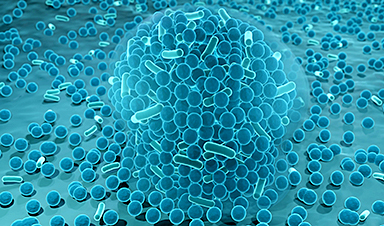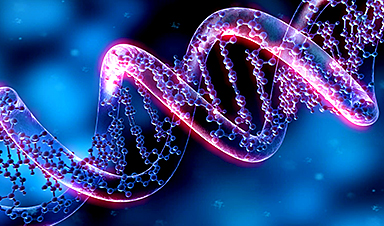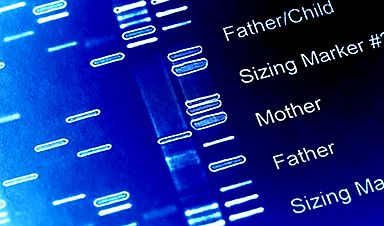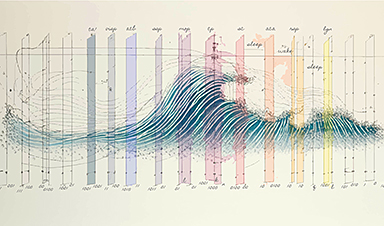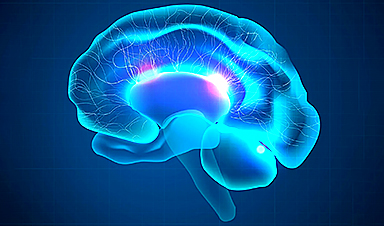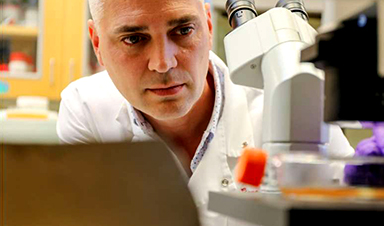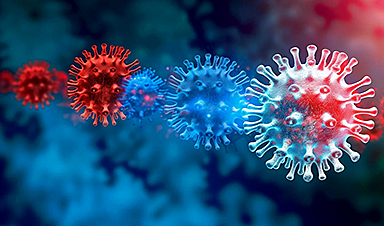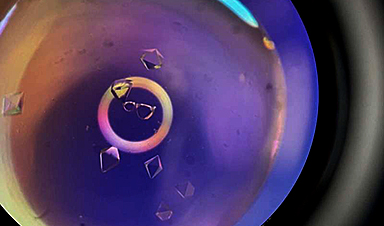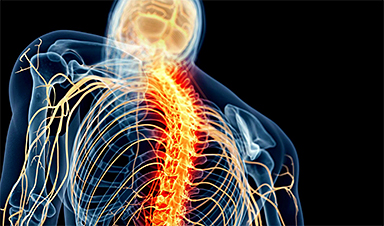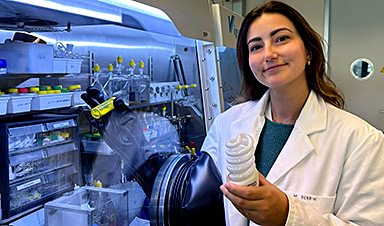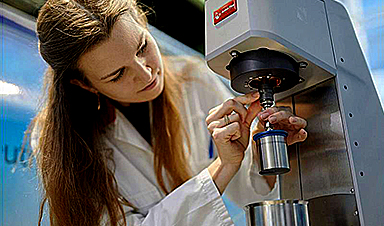A group of tiny RNA that should attack the virus causing COVID-19 when it tries to infect the body are diminished with age and chronic health problems, a decrease that likely helps explain why older individuals and those with preexisting medical conditions are vulnerable populations, investigators report.
MicroRNAs play a big role in our body in controlling gene expression, and also are a front line when viruses invade, latching onto and cutting the RNA, the genetic material of the virus, says Dr. Sadanand Fulzele, aging researcher in the Department of Medicine and Center for Healthy Aging at the Medical College of Georgia at Augusta University.
But with age and some chronic medical conditions, the attacking microRNA numbers dwindle, reducing our ability to respond to viruses, says Dr. Carlos M. Isales, co-director of the MCG Center for Healthy Aging and chief of the MCG Division of Endocrinology, Diabetes and Metabolism.
Much like not having enough troops on the ground in an actual war, the coronavirus is then better able to do what it does naturally, which is hijacking our cell machinery so it can replicate, say the researchers who report in the journal Aging and Disease what appear to be key microRNA involved in responding to this virus. They have a longer-term goal of identifying the biggest hitters and replenishing those troops.
They looked at the RNA sequence of actually two coronaviruses, SARS, which surfaced in 2002, and SARS-CoV-2, which causes COVID-19, and the sequence of the microRNAs that appeared to be attacking the virus, then used computer simulation to figure out which would logically fit together like puzzle pieces. Their perusal included four samples of SARS and 29 samples of SARS-CoV-2, taken between January and April 2020 from five continents covering 17 countries from the United States to Germany to Thailand.
They found 848 microRNAs that target the SARS genome and 873 microRNAs that target SARS-CoV-2 genome. They found 558 of the microRNAs fighting SARS also present in SARS-CoV-2, while 315 microRNAs were unique to SARS-CoV-2, and 290 were unique to SARS. MicroRNAs most proficient at attacking SARS-CoV-2 showed more than 10 target sites and might ultimately be found to be the most proficient at fighting the virus, which, in a few months, has changed much of the way the world functions.
They also found the microRNAs targeting SARS-CoV-2 were associated with more than 72 biological processes — from the production of molecules to the immune response — and that many are known to become dysregulated and/or diminish in number with age and with underlying medical conditions like diabetes and cardiovascular disease, a likely factor in the increased disease presentation and death rates seen in these individuals, the investigators say.
An example is microRNAs like miR-15b-5p, which has a high affinity for SARS-CoV-2, but is downregulated in coronary artery disease, says corresponding author Fulzele. In healthy, younger people, these microRNAs whose nature is to bind to the virus, are more apt to do as they should and prevent replication, he adds.
In the 29 worldwide samples of SARS-CoV-2, 19 had identical microRNAs, which indicates the virus has a fairly uniform presence internationally and that any effective treatments or vaccines should have broad impact, Isales says.
Next steps include studies in culture and lab animals to ensure findings are consistent with the computer analysis of human microRNAs in this study.
“The most important and striking feature of COVID-19 is the increased case fatality rate in aged individuals,” the investigators write, with the CDC reporting that nearly half of patients requiring hospitalization are age 65 and older, and these more senior individuals account for about 80% of the deaths. Fulzele, Isales and their colleagues wanted to know more about why.
“My perspective is there is a key set of microRNAs that are important in triggering this abnormal response, in making older patients more susceptible,” says senior author Isales. “We are looking at microRNAs in general dropping, but there is a specific subset that is key. The question is whether we can we target those as a therapy.”
Cocktails of multiple key microRNA, potentially given through the nose, might help restore sufficient levels of the key virus fighters, the investigators say.
They already are moving toward producing synthetic microRNA that could supplement this frontline weakened by age or disease, Fulzele says. Future studies also include pinning down which microRNA would be most impactful as an adjunct therapy, for example with the drug remdesivir, under study now for COVID-19, which works to stop the virus’ pirating of healthy cell machinery.
Another question to pursue is whether some younger people, who also are seriously sickened by SARS-CoV-2 infection, already don’t make sufficient numbers of some of the key protective microRNA, Isales says.
Image Credit: Envato/Amanda Scott
Thanks to Heinz V. Hoenen. Follow him on twitter: @HeinzVHoenen
News This Week
Breakthrough in Antimicrobial Technology with Cinnamon-Based Nanokiller
The need for innovative antimicrobial agents has become increasingly urgent due to the rise of antibiotic-resistant pathogens and the persistent threat of infections acquired during hospital stays. Traditional antibiotics and antiseptics are often ineffective [...]
The Silent Battle Within: How Your Organs Choose Between Mom and Dad’s Genes
Research reveals that selective expression of maternal or paternal X chromosomes varies by organ, driven by cellular competition. A new study published today (July 26) in Nature Genetics by the Lymphoid Development Group at the MRC [...]
Study identifies genes increasing risk of severe COVID-19
Whether or not a person becomes seriously ill with COVID-19 depends, among other things, on genetic factors. With this in mind, researchers from the University Hospital Bonn (UKB) and the University of Bonn, in [...]
Small regions of the brain can take micro-naps while the rest of the brain is awake and vice versa
Sleep and wake: They're totally distinct states of being that define the boundaries of our daily lives. For years, scientists have measured the difference between these instinctual brain processes by observing brain waves, with [...]
Redefining Consciousness: Small Regions of the Brain Can Take Micro-Naps While the Rest of the Brain Is Awake
The study broadly reveals how fast brain waves, previously overlooked, establish fundamental patterns of sleep and wakefulness. Scientists have developed a new method to analyze sleep and wake states by detecting ultra-fast neuronal activity [...]
AI Reveals Health Secrets Through Facial Temperature Mapping
Researchers have found that different facial temperatures correlate with chronic illnesses like diabetes and high blood pressure, and these can be detected using AI with thermal cameras. They highlight the potential of this technology [...]
Breakthrough in aging research: Blocking IL-11 extends lifespan and improves health in mice
In a recent study published in the journal Nature, a team of researchers used murine models and various pharmacological and genetic approaches to examine whether pro-inflammatory signaling involving interleukin (IL)-11, which activates signaling molecules such [...]
Promise for a universal influenza vaccine: Scientists validate theory using 1918 flu virus
New research led by Oregon Health & Science University reveals a promising approach to developing a universal influenza vaccine—a so-called "one and done" vaccine that confers lifetime immunity against an evolving virus. The study, [...]
New Projects Aim To Pioneer the Future of Neuroscience
One study will investigate the alterations in brain activity at the cellular level caused by psilocybin, the psychoactive substance found in “magic mushrooms.” How do neurons respond to the effects of magic mushrooms? What [...]
Decoding the Decline: Scientific Insights Into Long COVID’s Retreat
Research indicates a significant reduction in long COVID risk, largely due to vaccination and the virus’s evolution. The study analyzes data from over 441,000 veterans, showing lower rates of long COVID among vaccinated individuals compared [...]
Silicon Transformed: A Breakthrough in Laser Nanofabrication
A new method enables precise nanofabrication inside silicon using spatial light modulation and laser pulses, creating advanced nanostructures for potential use in electronics and photonics. Silicon, the cornerstone of modern electronics, photovoltaics, and photonics, [...]
Caught in the actinium: New research could help design better cancer treatments
The element actinium was first discovered at the turn of the 20th century, but even now, nearly 125 years later, researchers still don't have a good grasp on the metal's chemistry. That's because actinium [...]
Innovative Light-Controlled Drugs Could Revolutionize Neuropathic Pain Treatment
A team of researchers from the Institute for Bioengineering of Catalonia (IBEC) has developed light-activated derivatives of the anti-epileptic drug carbamazepine to treat neuropathic pain. Light can be harnessed to target drugs to specific [...]
Green Gold: Turning E-Waste Into a Treasure Trove of Rare Earth Metals
Scientists are developing a process inspired by nature that efficiently recovers europium from old fluorescent lamps. The approach could lead to the long-awaited recycling of rare earth metals. A small molecule that naturally serves [...]
Cambridge Study: AI Chatbots Have an “Empathy Gap,” and It Could Be Dangerous
A new study suggests a framework for “Child Safe AI” in response to recent incidents showing that many children perceive chatbots as quasi-human and reliable. A study has indicated that AI chatbots often exhibit [...]
Nanoparticle-based delivery system could offer treatment for diabetics with rare insulin allergy
Up to 3% of people with diabetes have an allergic reaction to insulin. A team at Forschungszentrum Jülich has now studied a method that could be used to deliver the active substance into the [...]

